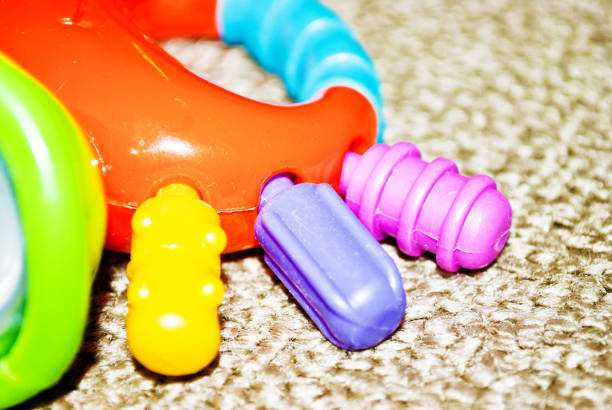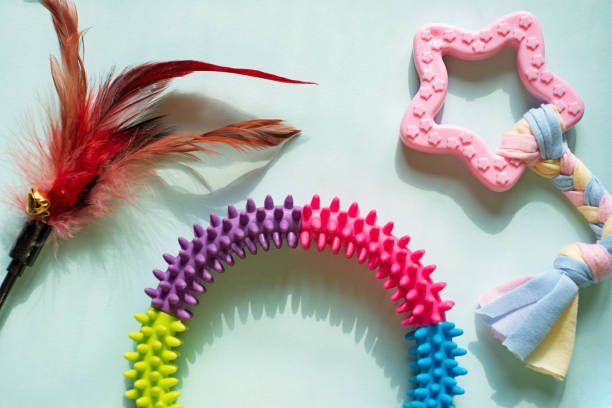Did you know that up to 90% of children with autism engage in some form of self-stimulation, with oral stimulation being one of the most common behaviors? Chewable stim toys (also known as chews or chewable stimulation toys) are innovative tools designed to provide a safe and effective outlet for this need. More than just fancy accessories, these toys are powerful self-regulation tools for those with autism, ADHD, sensory sensitivities, and anxiety. From relieving stress to improving focus and even supporting oral motor development, chewable stimulation toys have extraordinary potential for all ages and situations.
Break out of the box and dive into the science of chewing as a stimulation behavior, explore how chewable stimulation toys can benefit you, what aspects of stimulation that are overlooked when choosing the right one are really important, and get a fresh perspective on how they can change lives.
Decoding Chew Stimulation Toys: What They Are and Why They Matter
Chew stim toys are objects specifically designed to be chewed, providing oral sensory stimulation. While self-stimulation is often associated with autism, people of all ages use this behavior to regulate emotions or neural input. Specifically, chewing activates muscles and nerves, which can improve focus and relieve anxiety. Made from materials like durable, non-toxic silicone or latex-free rubber, they are able to withstand vigorous chewing while remaining safe. These toys are a healthier alternative to chewing on non-edible objects like clothing, pencils, or fingers, which can lead to damage or injury.
The importance of chew stim toys is that they satisfy sensory needs in a socially acceptable and safe way. For people with autism or sensory processing disorders, oral stimulation is a natural mechanism for self-regulation, anxiety relief, or increased focus. Unlike standard fidget toys, chew stimulation toys provide oral proprioceptive feedback—providing resistance, texture, and rhythm to soothe the nervous system. This makes them ideal stimulation toys for adults with autism, neurodivergent children, and those with sensory processing disorders. By providing a designated chew object, these toys prevent damage to other items and support sensory integration, helping the brain process sensory input more effectively.
According to a study published in Frontiers in Psychology, repetitive oral-motor input, like chewing, has been linked to increased cognitive focus in children with ADHD, reducing classroom disruptions and boosting academic performance.

The Science Behind Chew Stim Toys
1.How They Work
To understand why chew stim toys are so effective, we need to explore sensory processing—the way our nervous system interprets sensory information and translates it into appropriate responses. For individuals with autism or sensory processing disorders, this process can be atypical, leading to over- or under-sensitivity to stimuli like sounds, lights, or textures.
Chewing provides proprioceptive input, which helps the brain understand the body’s position and movement. This sensory feedback can be grounding, especially for those overwhelmed by external stimuli. The rhythmic action of chewing also activates the parasympathetic nervous system, promoting relaxation and reducing stress. Research supports these effects:
- A study published in Semantics Scholar suggests that oral motor activities, such as chewing, can help individuals with autism calm themselves and improve focus.
- Another study in ScienceDirect found that oral motor stimulation reduces hyperactivity and enhances attention in children with autism spectrum disorder (ASD).
These findings highlight the therapeutic potential of chew stim toys as tools for sensory regulation and emotional well-being.
2.Positive Effects
What conditions can be relieved by stim toys, especially chew ones? While chew stim toys are not medical devices, they have shown effective results in managing:
- Autism Spectrum Disorder (ASD): Helps modulate sensory overload by providing controlled, repetitive feedback.
- ADHD and Executive Function Challenges: Chewing can serve as a grounding strategy for inattentive or hyperactive minds.For example, many studies now show that chew necklaces relieve ADHD patients and people with sensory executive difficulties, and have certain sensory stimulation and re-reaction effects.
- Anxiety and Emotional Regulation: Offers immediate, portable stress relief by occupying the mouth and reducing the urge for harmful behaviors (e.g., nail biting, lip chewing).
✨ Case Insight:
One parent reported that switching from thumb-sucking to a stim necklace significantly reduced their child’s nighttime anxiety and teeth grinding. Their occupational therapist endorsed it as a long-term oral sensory strategy.
Chew Stimulation Toys for Humans: Breaking the Taboo of Age
Let’s address a common misconception: chew stim toys are not just for children. Adults also stim — and increasingly turn to chew stim toys for humans. While some may hesitate due to stigma, the demand for stim toys for autistic adults and anxious professionals is rising.
👄 Real-World Example:
Many adult users in high-pressure jobs use low-profile chew stim necklaces (e.g., black silicone pendants that resemble tech accessories) to manage workplace stress discreetly.
➡️ A growing market for aesthetic chew stim jewelry helps normalize oral stimming among adults, promoting acceptance and accessibility.
Types of Chew Stim Toys: Choosing The Best One
Chew stim toys come in a variety of forms, each offering unique sensory experiences to cater to different needs and preferences. Here’s a breakdown of the most common types:
| Type | Description | Best For |
|---|---|---|
| Chewelry | Wearable necklaces or bracelets made from silicone or other safe materials. | Discreet use in school, work, or social settings. |
| Chew Sticks and Tubes | Handheld chews with varying textures and strengths. | Heavy chewers or those preferring tactile input. |
| Vibrating Chews | Chews with gentle vibrations for added sensory stimulation. | Users seeking extra calming effects. |
| Chewable Pencils/Toppers | Pencils or toppers designed for chewing during writing or school activities. | Students needing focus during tasks. |
| Fabric Chews | Soft, cotton-based chews that are gentler on the teeth. | Light chewers or those preferring softer textures. |
When choosing a chew stim toy, consider the user’s chew strength (light, moderate, or heavy), texture preferences, and the environment where the toy will be used. For instance, a stim necklace might be ideal for school or work due to its portability, while a chew stick could be better for home use.
How to Choose the Perfect Chew Stimulation Toy
Selecting the right chew stim toy requires careful consideration of several factors:
- Chew Strength: Toys are rated for light, moderate, or heavy chewers. Matching the toy’s durability to the user’s chewing intensity ensures safety and longevity. For example, ARK Therapeutic offers chews in three toughness levels (source).
- Material Safety: Choose toys made from non-toxic, BPA-free materials that are safe for mouthing. Regular safety checks are advised to ensure durability (source).
- Accessibility: Wearable options like chewable stim toys in necklace form are ideal for on-the-go use, while handheld chews suit specific activities.
- Personal Preferences: Texture, shape, and color influence user comfort. Some prefer smooth surfaces, while others enjoy bumpy or ridged textures.
📝 Pro Tip:
Always choose BPA-free, food-grade silicone for safety, especially for those who use chew stim toys regularly.
Involving the user in the selection process can enhance acceptance, especially for adults who may feel self-conscious about using sensory tools. Starting with discreet options like stim necklaces can help overcome stigma, as discussed in personal accounts (source).

Benefits Of Chewing Stimulation Toys For Different Groups
1.Chew Stim Toys for Autism Kids: Development and Relief in One Tool
In the context of stimming toys for autism kids, chewables are often integrated into occupational therapy plans. They support:
- Oral motor development (important for speech and feeding skills)
- Emotional regulation during meltdowns or transitions
- Social acceptance in group settings (especially when disguised as stylish accessories)
🧸 Case in Point:
A school in California introduced chewable stim necklaces.For example, making chew necklaces for children as part of their inclusive learning, sensory and teething kits. Teachers reported improved focus during lessons and reduced disruptive behaviors among neurodivergent students.
2.Benefits for Adults with Autism and Other Conditions
Stim toys for autistic adults are equally impactful, offering discreet and effective sensory support. For adults with autism, chew stim toys can:
- Reduce Anxiety: Chewing provides a calming effect, helping manage stress in professional or social settings. A stim necklace can be worn discreetly under clothing for quick access.
- Enhance Focus: Oral stimulation can improve concentration during tasks like meetings or studying, as noted in research on oral motor activities (source).
- Meet Oral Sensory Needs: Adults who grind their teeth or chew on non-edible items can redirect this behavior to safe alternatives, improving overall well-being.
Beyond autism, chew stim toys for humans with ADHD, anxiety, or sensory processing disorders can benefit from oral stimulation. For example, someone with ADHD might use a chewable pencil topper to stay focused during work, while an individual with anxiety could find relief through chewing to reduce nervous energy. Even neurotypical individuals experiencing sensory overload may find these tools helpful.
Chew Stim Toys Are Beyond The Ordinary
1.How Chew Stim Toys Changed Lives
The impact of chew stim toys is best illustrated through real-life stories:
- Emma’s Story: Emma, a 10-year-old with autism, frequently chewed on her shirt collars, leading to damaged clothing and social challenges. After introducing a chew stim necklace, her inappropriate chewing decreased, and her focus in class improved significantly.
- John’s Experience: John, an adult with ADHD, struggled to stay engaged during long work meetings. Using a chewable pencil topper allowed him to maintain focus without distracting colleagues, enhancing his productivity.
- Sarah’s Journey: Sarah, a teenager with sensory processing disorder, had a habit of biting her nails and cuticles, causing pain and infections. A chew stick redirected her chewing to a safe alternative, improving her physical and emotional well-being.
These stories, inspired by real-world experiences (source), demonstrate how chew stim toys can address specific conditions relieved by stim toys, fostering better focus, reduced anxiety, and improved social interactions.

2.Unexpected Benefits and New Frontiers
While most blogs stop at recommending a few Amazon links, let’s take it a step further. Here’s how chew stim toys are finding a place in wider wellness and educational contexts:
- Mental Health Programs: Therapists integrate chew tools into grounding exercises for trauma and PTSD recovery.
- Mindfulness Practice: Chewing offers rhythmic repetition that mimics deep breathing, ideal for calming routines.
- Education Tech: Some smart chewables now track usage data, providing insights into emotional patterns and triggers.
💡 Interesting Note:
A growing number of neurodiversity advocates argue for insurance reimbursement of stim toys as assistive sensory tools — and chew stim options are leading that charge.
Embracing the Chew for a Better Quality of Life
Chew stim toys aren’t a fad, but part of a broader movement toward sensory inclusion and neurodiversity empowerment. They can enhance focus, reduce stress, and improve overall quality of life. Whether you’re a parent of a child with autism, a professional seeking focus, or someone working on self-regulation, there’s a wide range of stimulation toys on the market, from chew toys to vibrating chew toys, there’s something for everyone.
By understanding their psychological and physical benefits, and choosing the right type, users can transform everyday stress and overstimulation into calm, comfort, and control. Explore the world of human chew stimulation toys today and learn how they can unlock new levels of comfort and focus.
Citations
Suggested Resources:


